Difference between revisions of "Fuirena squarrosa"
(→Taxonomic Notes) |
|||
| Line 35: | Line 35: | ||
===Phenology=== <!--Timing off flowering, fruiting, seed dispersal, and environmental triggers. Cite PanFlora website if appropriate: http://www.gilnelson.com/PanFlora/ --> | ===Phenology=== <!--Timing off flowering, fruiting, seed dispersal, and environmental triggers. Cite PanFlora website if appropriate: http://www.gilnelson.com/PanFlora/ --> | ||
| − | Flowering time ranges continuously from August until October, while fruit development has been seen in the months of May and October. <ref name= "Herbarium"/> | + | This species generally flowers from July until October.<ref name= "Weakley"/> Flowering time ranges continuously from August until October, while fruit development has been seen in the months of May and October. <ref name= "Herbarium"/> |
<!--===Seed dispersal===--> | <!--===Seed dispersal===--> | ||
<!--===Seed bank and germination===--> | <!--===Seed bank and germination===--> | ||
Revision as of 15:57, 13 May 2019
Common name: hairy umbrella-sedge; salt-marsh umbrellagrass
| Fuirena squarrosa | |
|---|---|

| |
| Photo by the Atlas of Florida Plants Database | |
| Scientific classification | |
| Kingdom: | Plantae |
| Division: | Magnoliophyta - Flowering plants |
| Class: | Liliopsida - Moncots |
| Order: | Poales |
| Family: | Cyperaceae |
| Genus: | Fuirena |
| Species: | F. squarrosa |
| Binomial name | |
| Fuirena squarrosa Michx. | |

| |
| Natural range of Fuirena squarrosa from USDA NRCS Plants Database. | |
Contents
Taxonomic Notes
Synonyms: Fuirena hispida Elliott
Description
F. squarrosa is a native perennial graminoid that is a member of the Cyperaceae family [1]. Species in this family grow reproductive units in the form of spikelets, which contain highly simplified flowers [2]. F. squarrosa has alternate simple leaves shaped linearly, and contains a fibrous root structure like most Monocots [3].
Distribution
The species can be found in the Southeast United States, ranging from Texas to Virginia, as well as in the Northeast in Maryland, New Jersey, and New York [1]. It becomes more rare in communities located in Tennessee, Delaware, and New Jersey [4].
Ecology
Habitat
F. squarrosa can be found in mesic communities, including sphagnous bogs, [5] and can be found infrequently in pine-palmetto communities and wet prairies [6]. As well, F. squarrosa is present in habitats ranging from wet sandy loams of roadside depressions and other wet loamy sand disturbed sites. [7]
Associated species - Eleocharis tuberculosa, Gentiana saponaria, Bartonia paniculata, Platanthera cristata, Pyrus arbutifolia, and Viburnum nudum [5].
Phenology
This species generally flowers from July until October.[8] Flowering time ranges continuously from August until October, while fruit development has been seen in the months of May and October. [7]
Fire ecology
Sphagnous bogs and other similar communities are fire dependent due to their high acidity, which makes F. squarrosa dependent on fire frequency [9].
Conservation and Management
Cultivation and restoration
Photo Gallery
References and notes
- ↑ 1.0 1.1 USDA Plants Database URL: https://plants.usda.gov/core/profile?symbol=FUSQ
- ↑ Reutemann, A. G., Vegetti, A. C., and Pozner, R. Inflorescence development in Abildgaardieae (Cyperaceae, Cyperoideae). Flora 210: 3-12.
- ↑ Ladybird Johnson Wildflower Center URL: www.wildflower.org
- ↑ NatureServe Explorer URL: http://www.natureserve.org/explorer/
- ↑ 5.0 5.1 Bridges, E. L. and S. L. Orzell (1989). "Syngonanthus flavidulus (Eriocaulaceae) new to Mississippi." SIDA, Contributions to Botany 13(4): 512-515.
- ↑ Hilmon, J. B. (1964). "Plants of the Caloosa Experimental Range " U.S. Forest Service Research Paper SE-12
- ↑ 7.0 7.1 Florida State University Robert K. Godfrey Herbarium database. URL: http://herbarium.bio.fsu.edu. Last accessed: June 2018. Collectors: Loran C. Anderson, Ed Keppner, Lisa Keppner, Travis MacClendon, Karen MacClendon, George Wilder, J. Roche, R. A. Norris, Helen Roth, Floyd Griffith, and Richard Carter. States and counties: Florida: Putnam, Bay, Calhoun, Leon, Gadsden, and Jackson. Georgia: Brantley.
- ↑ Cite error: Invalid
<ref>tag; no text was provided for refs namedWeakley - ↑ Campbell, C. S. (1983). "Systematics of the Andropogon virginicus complex (Gramineae)." Journal of the Arnold Arboretum 64(2): 171-254.